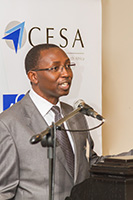 Consulting Engineers South Africa’s (CESA) President, Abe Thela, recently presented his presidential message and theme for the year at a function held in Johannesburg. With the theme of ‘Meeting Socio-Economic Challenges through Sustained Infrastructure Investment’ Thela stated thatthis year CESA will be focusing on the role infrastructure plays in the socio-economic development of our country and how this role can be enhanced through an increase in infrastructure investment and skills development.
Consulting Engineers South Africa’s (CESA) President, Abe Thela, recently presented his presidential message and theme for the year at a function held in Johannesburg. With the theme of ‘Meeting Socio-Economic Challenges through Sustained Infrastructure Investment’ Thela stated thatthis year CESA will be focusing on the role infrastructure plays in the socio-economic development of our country and how this role can be enhanced through an increase in infrastructure investment and skills development.
Social, political and economic realities
The National Planning Commission identified the two most pressing challenges facing the country as being the fact that too few South Africans are employed and that the quality of education for poor black South Africans is substandard. The unemployment rate is estimated at 25.4% and of great concern is the fact that 50% of unemployed South Africans are youth between the ages of 15 and 24 years. This figure escalates to 63% if the discouraged youth job-seekers are added to the statistics.
Thela states that, “These problems coupled with the rising youth population reflect a generation at risk, contribute to socio-political disorder, put heightened strain on the country’s limited financial resources and arrest economic growthâ€.
Increasing infrastructure investment
According to the NDP South Africa will need to spend at least 30% of its GDP on infrastructure development to allow infrastructure to have a meaningful contribution in eradicating poverty, halving the unemployment rate and contributing to economic growth to the desired level of between 5 and 7% per annum by 2030. Currently the country is only managing 22.9% of GDP on infrastructure spending with the public sector contributing 13.95% and the private sector 8.95%. The respective targets for the public and private sectors are 20% and 10%.
He contends that, “It is therefore clear that the starting point for addressing the country’s socio-economic challenges is to increase investment in infrastructure developmentâ€.In order for South Africa to address its socio economic challenges both public and private sectors will have to increase their spending on infrastructure with the public sector needing to increase more.
Leveraging private sector resources
The use of the Public-Private Partnerships (PPPs) in the financing, design, building and operation of infrastructure has emerged as the most important model employed by governments around the world to close the infrastructure gap. South Africa has not yet realized the full potential of this model of infrastructure delivery. Many opportunities exist in various economic sectors such as renewable energy, transportation, water, alternative energy sources, education, etc. where the PPP model can be used to maintain the momentum of infrastructure development in the country. However, the process must be transparent, the project pipeline clearly defined, regulatory red tape removed and the public must get better and more cost effective services.
Addressing inefficiencies in the procurement system
CESA has, for some time now, been aware that there are inefficiencies in the way public-sector infrastructure projects are implemented.These shortfalls include lack of planning, inappropriate procurement approaches, lack of project management capacity & capability, lack of other desired technical skills in the public sector, rampant corruption, etc. In addition these inefficiencies rob South Africa of multiple billions of Rands annually, which could be effectively used to fund the much-needed increase in infrastructure investment
Improve investment credit rating
In November 2014 Moody’s Rating Agency downgraded South Africa’s ‘investment grade’ credit rating to Baa2 from Baa1 and adjusted the outlook to stable from negative. It is crucial for the country to improve its investment grade rating to continue to access credit from both local and foreign lenders at favourable interest-rates. Unfavourably high interest-rates on loans reduce the value of the loans and accordingly the amount spent on infrastructure.
Human capital development
The increase in infrastructure investment will require more engineers, technicians and artisans to implement new infrastructure projects and maintain the existing infrastructure. The availability of skills is one of the elements that investors wanting to invest in a country consider with the level of skills determining the country’s productivity and competitiveness.
There are a number of concerns regarding human capital development in the country and these require unique programmes focused on addressing them. These concerns must be addressed as a minimun: Poor quality of basic education including maths and science;Youth unemployed and unemployable;Structure of the education system;Youth with qualifications but without experience.
Thela believes that, “Failure to tackle these challenges decisively with a systematic approach will deprive a whole generation of opportunities to develop their potential, escape poverty and support the country’s trajectory toward inclusive growth and economic transformation. CESA with the backing of our over 500 strong member firms recommit ourselves to partner with Government and other role players in finding lasting and practical solutions to these problems, especially in relation to infrastructure development.â€
